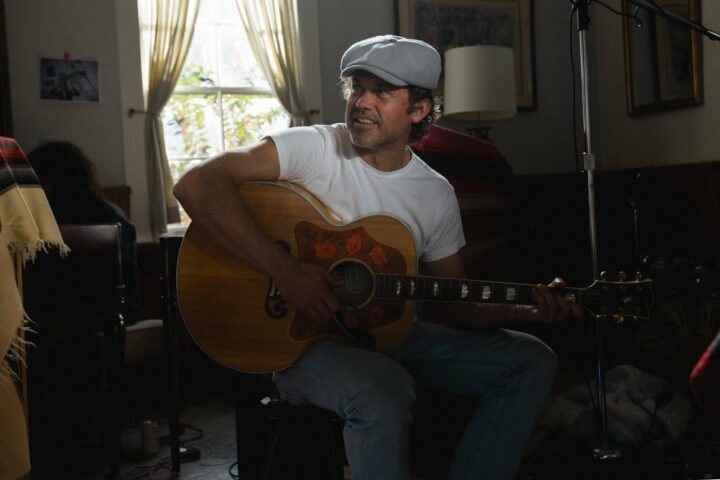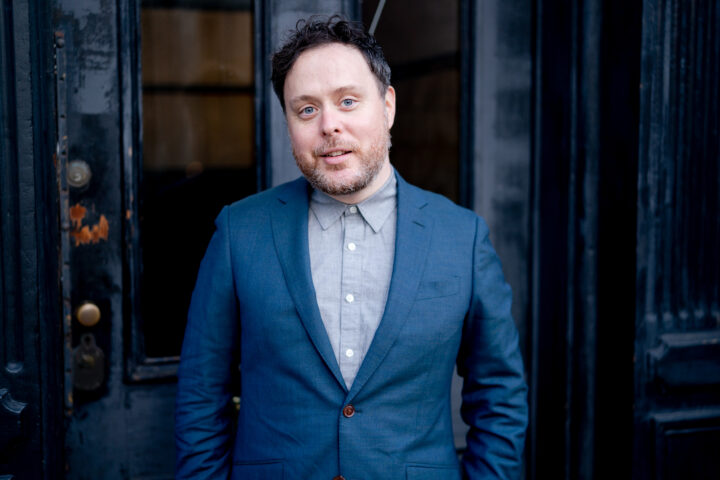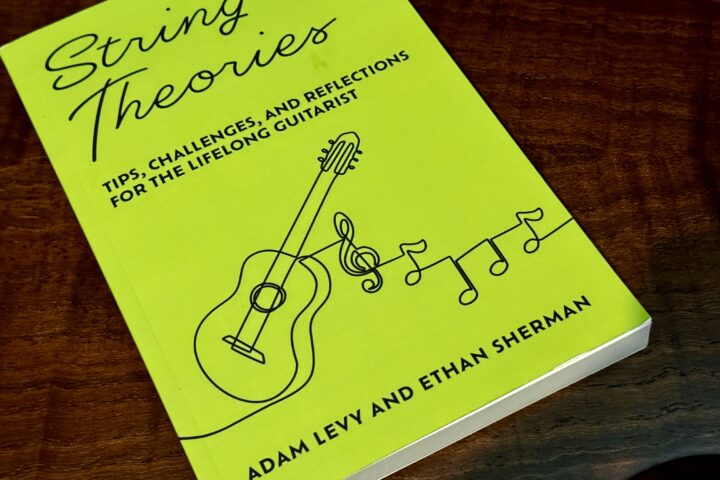Lately, all of our favorite musicians seem to be in the midst of duo projects: Chris Eldridge and Julian Lage; Eric Skye with mandolinist Tim Connell and Grant Gordy with Joe K. Walsh… we even hear Chris Thile has an album coming out with Brad Mehldau. The list goes on and on.
To add to that list, Gordy just announced another duo project, an album with guitarist Ross Martin entitled Year of the Dog. Since we got our copy here at the FJ, the album has been on heavy rotation. It’s a delightful, 10-track affair with incredible playing and some of the best acoustic engineering we’ve heard in recent memory (you’ll read how they did it, below). The playing is superb and the source material ranges from Bach to bluegrass to original compositions. We decided to ask Gordy about it.
Fretboard Journal: How did this duo project come about?
Grant Gordy: It feels like it’s been a long while in the making. When I lived in Colorado in my early twenties, I kept hearing about this guy, Ross Martin. He was the first-call guy on seemingly all the recording sessions and gigs, and when I heard his playing I understood why! I knew I needed to meet him. We finally met at a party in Boulder – it was probably 12 or 13 years ago. Had a chance to do some jamming and afterwards we made a point to get together as much as we could. The funny thing with guitarists is that it can be hard to cross paths, since there aren’t usually two guitar players on the same gig! But we’d connect at festivals, and meet up at our respective places in Denver, drink lots of coffee and geek out. Ross always struck me as a cat whose playing I could always learn so much from. By the time we started playing, his sound was so developed and he was functioning with nuances of dynamics and harmony that I was just really impressed by. It put a huge stamp on my playing and thinking. He’s 12 years older than me and about a foot taller so I always looked up to him. Long before we were considering actually doing a project, I’d think about the way he might articulate a line or a chord voicing or something just the way I’d do with any other of my guitar heroes.
Ross moved to Brooklyn I think about 10 years ago, and I did around four. Being traveling musicians, we got together a surprising amount during that time we lived in different parts of the country. By the time I got here to New York City, we were ready to make it more of a real project. We’re both Dogs on the Chinese Zodiac, separated by one 12-year cycle, so Year of the Dog seemed like an interesting title for us. Aside from the astrological connection, we’ve also unintentionally followed our noses into some similar trajectories in life. We’ve both spent 10 years in Colorado with that few-year overlap, we’re both adventurous guitarists who like improvising and cast our nets fairly wide in the musical ocean. And we just totally love and get so much out of playing together. It made a lot of sense to do this project, and the timing seemed right.
FJ: The range of songs you cover on this album is pretty wide. How did you decide on these tracks? Did the concept of this record evolve as you got in the studio?
GG: Things did evolve as we recorded. A couple of the original pieces were quite new when we tracked them – Ross’ tune “Sweep,” for instance, had been performed a few times on gigs but the arrangement solidified, as I remember, while we were actually recording it, which isn’t uncommon in the studio in my experience. My tune “As the Crow Flies” was still being written right up until we sat down to cut it. Nothing really got axed, though some of the tunes turned out a little different than we might have expected, but then, that’s the nature of improvising.
We didn’t set out to make a stylistically diverse record. In fact, I don’t remember ever even thinking about that! It all just came down to what we like to play, what we wanted to hear. We did want to strike what felt like a balance of moods and textures, and I think we succeeded in that. We tried to balance who states the melody on which tune, too. The cool thing about two guitars is that there is so much possibility for texture – it doesn’t have to be just, “You solo, I’ll strum… Okay, now I’ll solo while you strum!” We’re always exploring that aspect.
FJ: You recorded this in Colorado… can you describe the studio setup?
We recorded at Swingfingers Studio up near Fort Collins, Colorado. It’s run by our good friend Aaron Youngberg, who’s a real fixture of the Colorado music scene, as well as a great engineer and banjo player. This is Aaron’s breakdown of the recording setup…
For me: A “spaced pair” setup, but we used more than two mics so calling a spaced pair isn’t exactly correct. The 12th-fret neck mics were a Royer 122 into a Forssell SMP2 preamp and a vintage Neumann KM84 into a Mercury V72 preamp. For the bridge mic, we used a Flea C12 into Forssell SMP2 preamp. For my right shoulder mic, a vintage Neumann U87 into a Forssell SMP2 preamp.
Ross also had a “spaced pair” setup. His 12th fret mic was a vintage Neumann KM54 into a Chandler Limited TG2 preamp; on the bridge he had a vintage Neumann M49 into a Chandler Limited TG2 preamp. His right shoulder mic was a Flea U47 into a Grace V3 preamp.
The room mic was a AKG 414 B-ULS (omni) into a Forssell SMP2 preamp.
FJ: That’s a lot of microphones! I see you also played a few different guitars, including a ’40s Martin 000-18, a 1975 Martin D-28 and a 1998 Collings D-1. Walk us through the thought process here: Why did you choose the Martin over the Collings on a given track, or vice versa?
GG: It was an interesting process. Lately I’ve been mostly defaulting to the ’44 ooo-18, just because I love that guitar so much. It can handle about anything (in fact, the entire Mr. Sun record, The People Need Light, I played the ooo), but it’s particularly called for on tunes where I want a warmer, more midrange sound; I love how it sounds on ballads and anything with space, where you can let the notes breathe a bit. I played my Martin D-28 (which is closest to Ross’ Collings D2-H) on “Snowflake Reel/Bright Size Life” because there’s this harmonized melody that we play together on “Snowflake” and we wanted the rosewood guitars to really blend for that cut.
Similarly with “Dear Old Dixie” – there’s so much ensemble melody playing on that track, and we went wholeheartedly with the two dreadnought sound for that one, which I played my Collings D1 on. The D1 is also set up with lower action, which I sorely needed at my disposal for such a fast tempo! Some of those lines are pretty tricky. I believe it was back to the ooo-18 with me for the rest of the record.
FJ: Between your work with Joe K. Walsh and this, you’ve been on quite a duo run… how does Ross differ from Joe as a partner?
GG: Duo playing has always been big for me. My dad and I played together a lot when I was younger - he’s a great guitar player – so I had a lot of early training in that kind of dialogue. It’s an entirely different kind of ensemble playing, with some very different sets of responsibilities and variables than a whole band. Joe K. Walsh, one of the best mandolin players I’ve ever heard, has been a musical brother for lots of years now, and we’ve played in lots of band scenarios together, but stripping it down two just the two of us is a unique thing. Joe has such a conversational style of playing, and his sense of rhythm is so driving while still being sensitive. That’s a hard balance but he strikes it. More generally, playing in a mandolin/guitar duo will present you with certain inherent guidelines. Because of the ranges and timbres of the two instruments, we try to think quite a bit about how to best support each other, and best support whatever is happening in the musical moment. But the roles are somewhat more defined, and there’s a bit more of a bluegrass related template.
With two guitars, the register you have to work with is bigger so there’s that orchestral option available, and we can switch off between different kinds of roles- one of us can be the bass player, or the piano player, or we can just make one big chord together so you can’t even tell who’s doing what. Powerful stuff!
And though we both flatpick, we didn’t set out to make a “flatpicking record.” There’s precedent for a guitar duet in so many genres of music, so it feels we’re bound only by our own creative limits. Ross’ background in jazz and improvised music and my love of lots of different kinds of harmony, combined with our mutual curiosity about textural possibilities available to two guitars, gives us a natural push to stretch our palates out as far as possible.
FJ: Any plans for a duo recording with Joe K. Walsh?
GG: We’ve talked about it! Nothing formalized yet but seems very likely in the next year.
FJ: Last question: What are some of your favorite duo records you think every guitarist (or non-guitarist) should check out?
GG: Here are some all-time favorites…
- Bill Evans/Jim Hall, Undercurrent
- Ron Miles/Bill Frisell, Heaven
- Charlie Haden/Keith Jarrett, Jasmine
- David Grisman/Tony Rice, Tone Poems (I wore this one out on cassette tape when I was a teenager)
- Charlie Haden/Hank Jones, Steal Away
- Sergio & Odair Assad, Latin American Music for Two Guitar
Order Year of the Dog from Bandcamp via this link. Photo by Justin Camerer.


